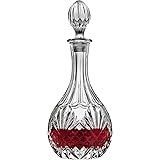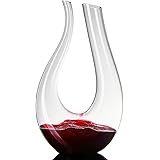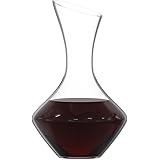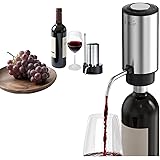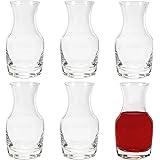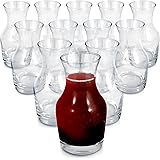The Ultimate Guide to Wine Glasses: A Sommelier’s Perspective on Enhancing Your Wine Experience
Have you ever found yourself staring at a wall of wine glasses, wondering if the shape truly makes a difference? Many wine enthusiasts wrestle with this very question, often feeling overwhelmed by the sheer variety available. The truth is, the right glass can profoundly transform your perception and enjoyment of wine, unlocking nuanced aromas and flavors you might otherwise miss. Fortunately, understanding the science and artistry behind these vessels is simpler than you think.
In the insightful video above, renowned Sommelier André Mack breaks down the fascinating world of wine glasses, explaining the unique purpose behind some of the most iconic designs. He illuminates how specific features—from the lip to the bowl—are engineered to deliver an optimal tasting experience for different wines. This guide expands on André’s expert insights, diving deeper into the nuances of each glass and offering practical advice to help you elevate every sip. Prepare to discover why ‘stemware’ exists for a reason and how a simple change in glassware can dramatically enhance your appreciation for wine.
The Anatomy of a Wine Glass: More Than Just a Vessel
Before exploring individual wine glass types, it’s essential to understand the four fundamental components that make up most traditional stemware. As André highlights, these include the lip, the bowl, the stem, and the base. Each part plays a crucial role in how you interact with and perceive the wine, from its temperature to its aromatic expression. A well-designed glass considers all these elements to maximize sensory engagement.
The thinness of the lip, for instance, is not just about elegance; it influences the wine’s seamless delivery to your palate, preventing any bulky interruption. The bowl’s shape dictates how aromas are captured and concentrated, while its size affects aeration. The stem, often overlooked, is vital for maintaining the wine’s ideal temperature, ensuring your hands don’t transfer warmth to the liquid. Finally, the base provides stability, allowing you to swirl and observe the wine without fear of spillage. Together, these components create a sophisticated tool designed for optimal enjoyment.
The Bulbous Beauty: The Burgundy Glass for Delicate Aromatics
When it comes to capturing delicate aromas, the Burgundy glass stands out with its distinctive, balloon-like shape. This generous bowl is specifically designed to concentrate the ethereal fragrances of wines like Pinot Noir, which are known for their complex, nuanced bouquets. As André explains, swirling the wine within this broad bowl allows the vapors to build and then become funneled towards your nose by the gently curving rim, enhancing aromatic detection.
Pinot Noir, a quintessential Burgundy grape, is characterized by its high acidity and often red fruit, earthy, or floral notes. The wide opening of the glass directs the wine to hit a broader part of your palate initially, spreading it evenly and accentuating its bright acidity and complex fruit characteristics. Imagine if you poured a finely aged Pinot Noir into a narrow glass; many of its subtle perfumes would dissipate too quickly, diminishing the full sensory journey. Instead, this glass ensures every delicate note is presented beautifully.
The Stately Structure: The Bordeaux Glass for Bold Reds
In contrast to the Burgundy glass, the Bordeaux glass, often referred to as a Cabernet glass, features a taller, slightly narrower bowl. This design is meticulously crafted for full-bodied, tannic red wines such as Cabernet Sauvignon, Merlot, and Bordeaux blends. André humorously describes it as “an oversized wine glass” that looks like it “got stung with a bee,” yet its unique shape serves a very deliberate purpose.
Wines from Bordeaux, and particularly Cabernet Sauvignon, are rich in tannins—compounds that impart a sensation of astringency and structure. These wines greatly benefit from aeration, which helps soften those tannins and allow their complex fruit and savory notes to emerge. The Bordeaux glass provides ample “headroom” or volume, acting almost as a mini-decanter, enabling the wine to interact with oxygen effectively. This promotes a delivery that spreads evenly across the palate, softening the wine’s intensity and showcasing its depth and power. It’s an ideal choice for most red wine enthusiasts due to its versatile and elegant appeal.
The Compact Classic: The White Wine Glass for Freshness and Acidity
Moving from robust reds to crisp whites, the typical Chardonnay or white wine glass is notably shorter with a smaller bowl compared to its red wine counterparts. While red wines often demand vast quantities of oxygen, white wines generally benefit from less exposure, helping to preserve their vibrant acidity and delicate aromatics. This smaller stature prevents rapid oxidation and helps maintain a cooler temperature, crucial for white wines.
The compact bowl concentrates the lighter, often more subtle aromas of white varieties, preventing them from dissipating too quickly. Imagine trying to capture the delicate citrus zest of a Sauvignon Blanc in a large Bordeaux glass; the aromas would be lost. However, André points out a fascinating personal preference: he sometimes prefers drinking Chardonnay from a larger Bordeaux-style glass, finding the delivery more satisfying. This highlights that while general guidelines exist, personal preference and the specific characteristics of the wine can always lead to unique and equally valid choices, especially with more aromatic or oaked Chardonnays that benefit from a bit more air.
The Petite Pour: The Dessert Wine Glass for Sweet Sensations
For those special moments at the end of a meal, the dessert wine glass makes a distinct appearance. Smaller in stature and often more fluted than a standard wine glass, it’s perfectly proportioned for serving fortified wines like Port or sweet delights such as Sauternes. As André notes, people typically don’t consume “copious amounts” of these richer, higher-alcohol wines, making the smaller capacity appropriate.
A standard dessert wine pour is approximately three ounces, contrasting sharply with the five-ounce pour of regular wine. Serving this smaller volume in a proportionally sized glass prevents the visual impression of an under-pour, which could disappoint a consumer. The fluted shape helps to channel the often intense, concentrated aromatics of sweet wines, directing them towards the center of the palate where sweetness perception is often accentuated. This glass not only enhances the tasting experience but also signals a shift in the dining ritual, marking the transition to the sweet culmination of a meal.
The Effervescent Duo: Champagne Flute vs. Coupe
No discussion of wine glasses is complete without exploring the vessels dedicated to sparkling wines. The most famous, the Champagne flute, is celebrated for its tall, narrow design. This slender shape, often only about two inches wide, is expertly crafted to facilitate the elegant rise of bubbles, showcasing their continuous stream. It minimizes the wine’s surface area exposure to air, thereby preserving the precious effervescence for longer.
However, André expresses a nuanced view, suggesting that while flutes are “fun” and “celebratory,” they don’t allow for proper evaluation of the wine itself. For serious Champagne, which is a complex wine, he sometimes prefers a white wine glass to truly appreciate its aromatics. In contrast, the coupe glass, a squat, broad-bowled predecessor to the flute, offers a completely different experience. Legend states its shape was modeled after Marie Antoinette’s breast, adding a historical mystique. While beautiful for cocktails and casual sparkling cider, its wide surface area means bubbles dissipate rapidly, making it less ideal for showcasing Champagne’s enduring sparkle. Both glasses offer distinct experiences, catering to different sparkling wine occasions.
The Casual Contender: The Stemless Wine Glass
Emerging in the late 1990s and early 2000s, the stemless wine glass represents a significant shift towards more casual wine consumption. As André points out, it omits two traditional components—the stem and the base—making it less dainty and more robust. This design encourages a relaxed approach to wine, perfectly pairing with trends like “good wine in a box” and outdoor gatherings.
While purists might lament the inability to hold it by the stem to control temperature, the stemless glass still retains a wide bowl, allowing for swirling and aromatic appreciation. It’s an ideal choice for picnics, backyard BBQs, or simply enjoying a refreshing rosé without the formality of traditional stemware. André appreciates its role in “bringing more people to the party,” broadening wine’s appeal by making it less intimidating and more accessible. Imagine enjoying a casual Rosé at the beach without worrying about a delicate stem breaking; this glass perfectly fits that scenario.
The Pinnacle of Versatility: The All-Purpose Wine Glass
For those seeking a single, exceptional glass that can admirably serve a wide range of wines, the all-purpose wine glass often becomes the ultimate choice. André highlights one such elegant example, noting its delicate, lightweight construction and razor-thin lip. While perhaps on the pricier side, its design principles can be found in more affordable versions, making the concept accessible to all.
This universal glass is designed to balance aroma capture with palate delivery, featuring a bowl that is neither too large nor too small, with a tapered rim that effectively concentrates aromatics. Its seamless delivery enhances the tasting experience across various wine styles, from robust reds to delicate whites. If the goal is to simplify your glassware collection without compromising quality, choosing one exceptional all-purpose glass that you genuinely enjoy drinking from is a truly wise decision. It offers a consistently great experience, proving that sometimes, less is indeed more when it comes to wine glasses.


